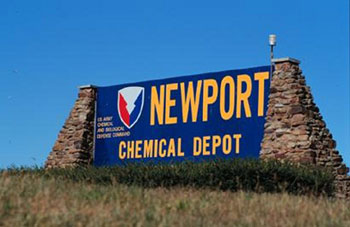In the modern world of terrorist fears and weapons of mass destruction few college students may realize one of the nation’s largest stockpiles of the VX nerve agent is kept down the road in Newport, Ind. The 7,000-acre facility that houses the storage and disposal site is a closed and guarded facility that can be scary and comforting.
Wabash’s Women on Campus Committee hosted two representatives Jan. 19 of the Newport Chemical Agent Disposal Facility to discuss the facility and its storage and planned disposal of the VX Nerve Agent.
 The Newport Chemical Weapons Depot was opened in 1941 as the Wabash River Ordinance Works to produce a variety of explosive munitions. In 1958 it was dedicated to the production of the VX nerve agent.
The Newport Chemical Weapons Depot was opened in 1941 as the Wabash River Ordinance Works to produce a variety of explosive munitions. In 1958 it was dedicated to the production of the VX nerve agent.
After the construction of the VX production facility was completed in 1961, the agent was produced until 1969 when a moratorium was placed on the production of the agent and its shipment across state lines. The final two batches of the agent, consisting of a couple million gallons of the agent, produced have been stored at the site since.
In 1997, the United States ratified the Chemical Weapons Convention. The international treaty called for the disposal of the US stockpiles of Mustard gas and the Sarin and VX nerve agents, and the procedures for the destruction of the various agents was undertaken at the stockpile sites. At the Newport site, the construction of the Chemical Agent Disposal facility was begun in 2000 and completed in 2003.
"The VX agent is tightly guarded and each drop is accounted for," Dr. Debbie Lander said, a chemist working at the Newport facility. "There’s an enormous amount of paperwork covering everything." The agent is stored as a viscous liquid in ton containers made with four inch thick walls of steel in hardened "igloos" made of concrete and steel.
The handling of the containers and safety are well practiced as the staff has undergone some 120,000 training hours with 13,000 hours dedicated to drill and exercise programs preparing for emergency response.
"Its always a relief when people learn its not a nerve gas that can spread so easily, and realize the amount of training the people working with it have to prevent accidents," Susan Gilman said. "The main purpose of the outreach office is to serve as a link between the Army and the community to help dispel the myths and rumors the public has about the facility, since it is a closed facility." Gilman, the director of the outreach office at the Newport facility, discussed many of the myths related to the agent and the construction of the disposal facility.
"Awareness is important," Lander said. "Awareness is what we’re looking for because the public doesn’t fully understand the neutralization process the agent undergoes and all the safety procedures in place." Lander participated in the presentation explaining some of the more technical aspects of the neutralization process and the chemical structure of VX.
The neutralization of the chemical agent is done by mixing the agent with water and Sodium hydroxide in an 8 percent agent to neutralizer ratio in the neutralization reactor.
Once the process has happened, the VX agent ceases to be and is left in a variety of chemical parts, the most dangerous of which is the remaining waste water, which is to be shipped to Maryland for further neutralization at facilities there. The disposal of the Nerve Agent itself is at a standstill for the moment as politics have halted the move forward, but disposal of the existing stock pile is expected to get underway in the early part of this year.
"I suggested to the Women on Campus Committee that we invite Newport after John Culley heard a presentation at Crawfordsville Kiwanis and said that it was very interesting," Terri Fyffe, a member of the committee, said. "I had read some articles in the newspaper about the facility and was concerned that such hazardous agents were stored so close to our homes in such times as we live."
"Having heard the presentation, I feel more at ease that the facility is safe and not a hazard to those of us living in West Central Indiana," Fyffe said. "The precautions taken seem pretty good, and the containers the VX is stored in along with the 'igloos' they built makes for much better security."
The Women on Campus meets the third Wednesday of each month to discuss issues ranging from public interest issues like the Newport facility, Identity theft and events and projects in the Crawfordsville community. The participants are generally the women working on campus or connected to the campus, with some of their programs open to the public.
Chatt is a Wabash College sophomore who writes for the Bachelor, the College's student newspaper.